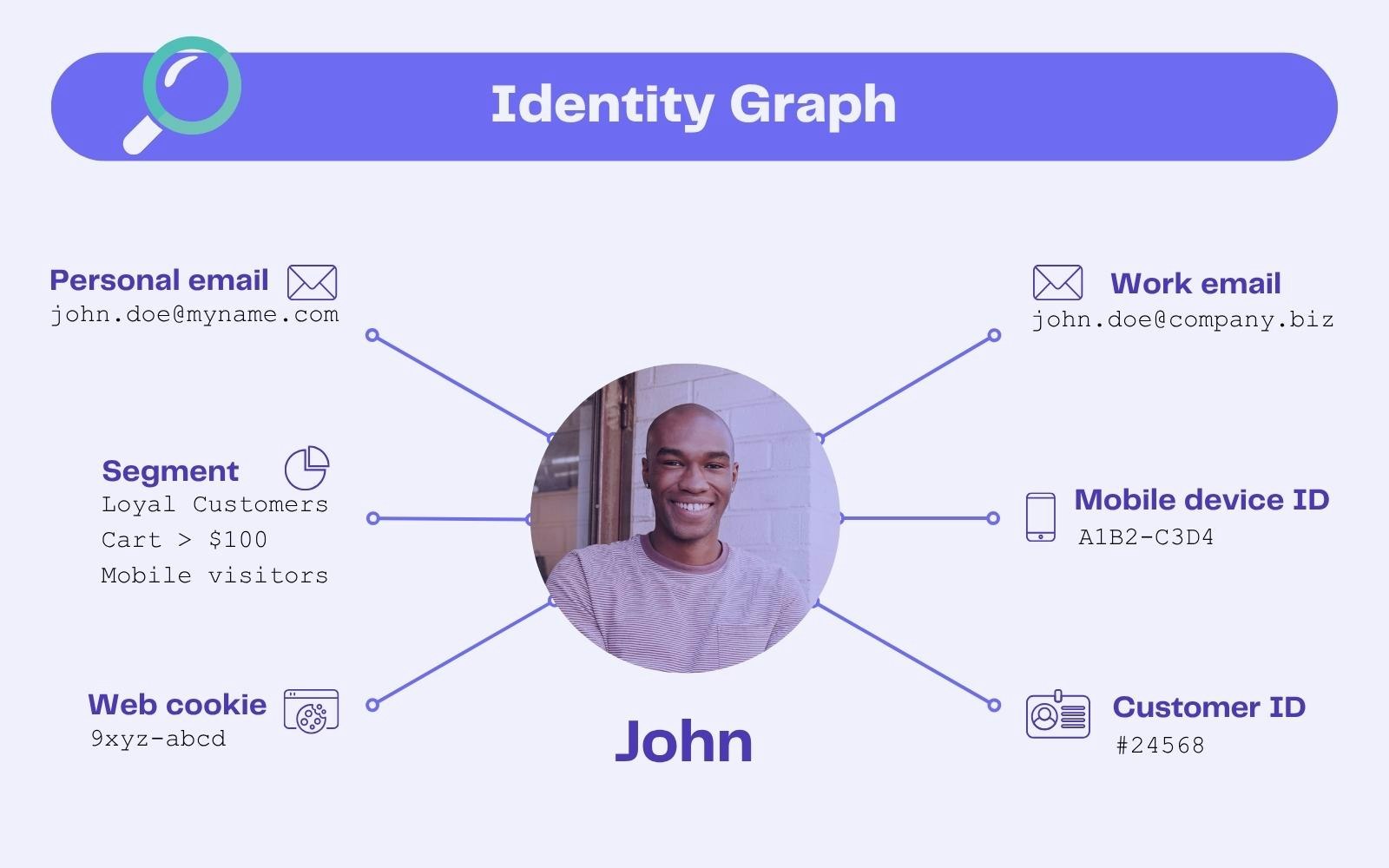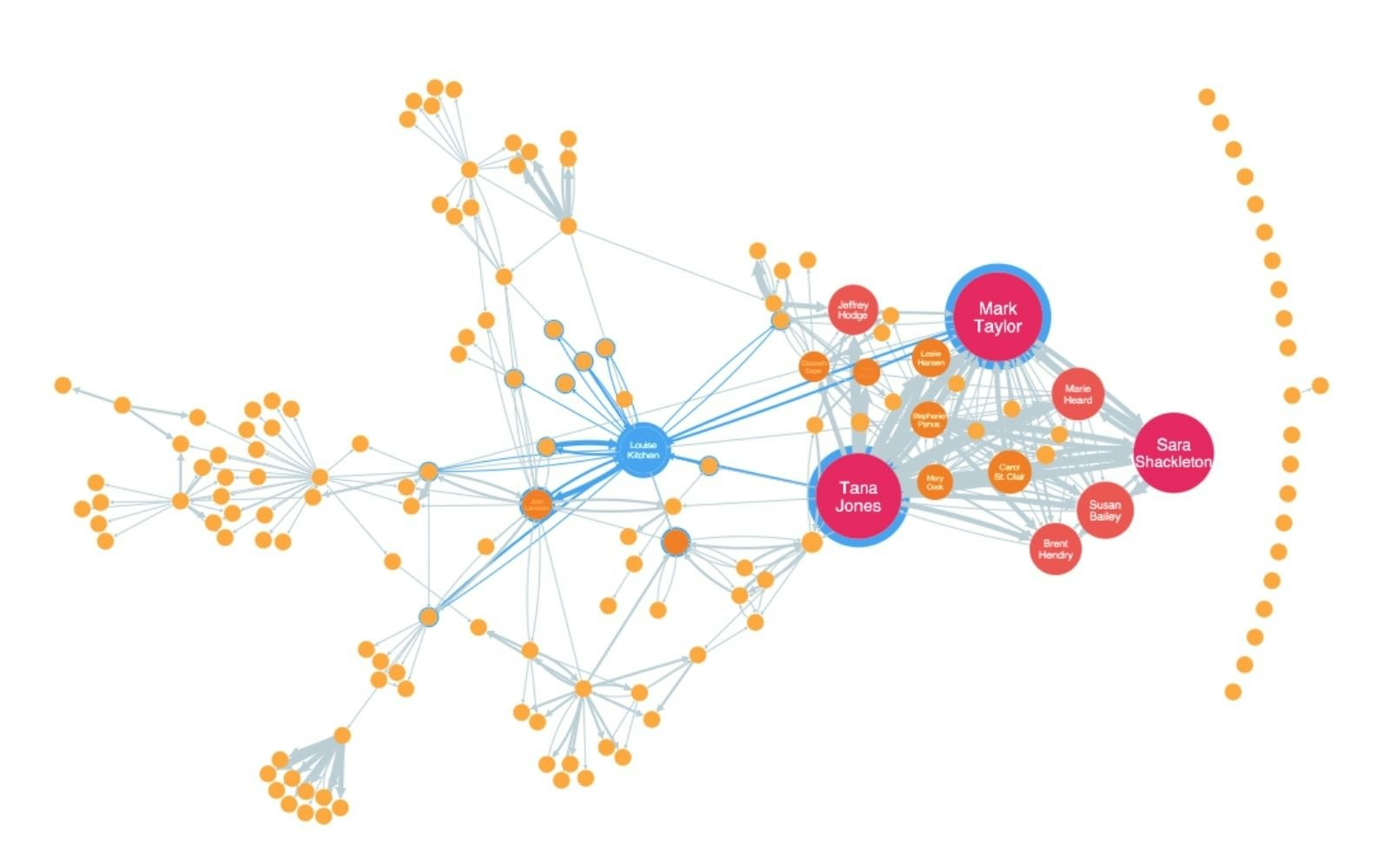
Identity Graph: The foundation for unifying your customer data
6min • Last updated on Oct 6, 2025

Olivier Renard
Content & SEO Manager
According to the well-known Rule of 7, a customer is said to interact with a business at least seven times before making a purchase.
A visit to a physical store, a message seen on Instagram, a Google search, an opened email… all across various devices and sometimes with different accounts. Touchpoints are multiplying, but they often remain siloed.
On the brand side, data is scattered and customer profiles fragmented. This leads to an incomplete view of the customer journey, which is difficult to leverage.
Key Takeaways:
An identity graph (or ID graph) is a structure resulting from identity resolution. It links multiple identifiers to the same individual to unify customer data.
The identity graph enables businesses to rebuild customer journeys, personalise messaging, and activate the right segments.
It is based on identity stitching from multiple sources (email, address, ID, phone number, cookie, etc.).
A composable CDP activates your data, centralised in the data warehouse, based on a unified customer view.
👉 Discover how an identity graph works and the role it plays in unifying your customer data. Learn how to integrate it into your approach to understand journeys, enrich profiles, and activate the right segments. 🎯
What is an identity graph?
An identity graph is a data structure that links multiple identifiers to a single individual.
Email addresses, CRM IDs, cookies, phone numbers, device IDs, purchase history… All of this information may belong to the same person, but be stored separately in different systems.
The role of the identity graph is to reconcile these data points to build a unified customer view.
This helps to better understand journeys, enrich user profiles, and activate the right segments, with no duplication or attribution errors.
💡 Imagine someone browsing a website on their mobile, subscribing to a newsletter with a personal email, then completing a purchase in-store using their loyalty card.
The identity graph acts as a matching table: it links these actions to a single profile.

ID graph identifiers
Identity Resolution, Identity Stitching, and Identity Graph: What’s the difference?
These three concepts are closely related and often confused, yet there are some distinctions:
Term | Description | Objective |
|---|---|---|
Identity stitching | Technique that links multiple identifiers to the same individual | Establish a reliable link between scattered data |
Identity graph | Data structure that organises these links | Store and exploit identity matches |
Identity resolution | Overall process including data collection, matching, and profile creation | Build a 360° customer view, usable by business tools |
ID resolution vs ID stitching vs ID graph
The role of the ID graph in a marketing strategy
In an omnichannel environment, a single customer interacts with your brand across many touchpoints: your website, mobile app, email campaigns, customer service, physical stores, and much more.
And across multiple devices: personal smartphone, self-service checkouts, smart TV, desktop or laptop, family tablet, etc. Add to this the various identifiers they may use: one email for purchases, another for newsletters, a phone number for customer service.
The resulting data is dispersed across various tools, with no clear link between them. This makes personalisation unreliable and marketing execution inefficient.
An identity graph helps reconcile these sources to create rich, accurate, and up-to-date profiles. It plays a central role in customer understanding by consolidating signals from across the entire journey.
Marketing teams can then better understand behaviour, anticipate needs, and tailor messaging.
Key use cases
With a well-structured identity graph, you can deploy highly targeted and relevant use cases, such as:
Analysing customer journeys and behaviours.
Automatically excluding inactive or already converted customers from campaigns.
Identifying and segmenting customers based on their lifetime value (LTV).
Creating seamless and personalised cross-channel journeys.
Enriching your database with behavioural data from the website or app to build an actionable Customer 360 view.
A response to today’s privacy challenges
The phase-out of third-party cookies, consent refusals, and retargeting restrictions are forcing companies to rethink their strategies. The best alternative? Leverage your own first-party data, collected through your owned channels.
The identity graph helps unlock the value of these proprietary data. It combines marketing effectiveness with privacy compliance, using a controlled infrastructure aligned with GDPR.
How does it work in practice?
Types of identifiers
An identity graph relies on deterministic or probabilistic identifiers to link various signals to the same individual.
Deterministic data includes unique and reliable information: email address, phone number, CRM ID, or customer account. This allows for precise and direct matching.
Probabilistic data, such as cookies, device IDs or digital fingerprints, offer a lower level of confidence. They are used to determine a match statistically, which is useful in certain contexts such as anonymous browsing or retargeting.
In practice, graphs combine both types of identifiers to expand coverage while maintaining reliability.
Building and updating the graph
Creating an ID graph is based on identity stitching and involves three key stages:
Collecte des identifiants issus de différents canaux (site, app, CRM, e-mail…)
Correspondance entre ces éléments, à l’aide de règles ou d’algorithmes
Association dans une structure unique, sous forme de graphe
The graph is composed of nodes (the identifiers) and links (the relationships between them). It is continuously updated to reflect all interactions across devices and channels, forming a reliable customer entity.
💡 User graph vs Household graph :
An ID graph can be built around a single person (user graph) or a household (household graph). The latter is useful in contexts like retail or connected TV, where multiple people may share a device or address.
Which tools are used?
Several tools are designed to model and store these complex graphs. Graph databases, such as Amazon Neptune or TigerGraph, can manage vast volumes of relationships.

Example of visualisation (source: Amazon Neptune)
Some integrated platforms (e.g. Adobe Experience Platform) offer ready-to-use identity graphs, based on their proprietary data and identifiers.
However, both options have drawbacks. The first is powerful but complex, intended for expert users. The second is more accessible but lacks flexibility.
In a modern data architecture, a composable CDP like DinMo uses information centralised in the company’s data warehouse. It creates an identity graph as a table directly within the data warehouse.
This warehouse-first approach avoids unnecessary duplication and gives business teams more flexibility.
What’s the relationship between ID graph, data warehouse and composable CDP?
These three components work in harmony within the Modern Data Stack.
The data warehouse (DWH) is the foundation. It centralises all customer data from various sources: website, CRM, customer service, transactions, loyalty programme, etc.
The identity graph links identifiers and reconstructs each customer profile via the identity resolution process.
The composable CDP activates this unified data directly from the warehouse, without duplication. It makes activation possible.
This modular approach is more streamlined, secure, and scalable. The data remains stored within the company’s own infrastructure.
At DinMo, we use the information in your data warehouse to help marketing teams build a unified customer view (Customer 360) without technical expertise.
Conclusion
The identity graph is at the heart of a data-driven marketing strategy. By linking multiple identifiers to the same individual, it becomes a cornerstone for understanding and activating your audiences.
More than a simple unification tool, it’s an operational asset to personalise campaigns, optimise journeys, and target the right segments.
Thanks to its composable structure, DinMo makes this technology accessible and directly actionable by marketing teams. Contact us to set up a POC!
FAQ
Is an identity graph GDPR-compliant?
Is an identity graph GDPR-compliant?
An identity graph can be used in a GDPR-compliant framework, provided that data is collected with the user’s consent.
By prioritising first-party data and applying techniques such as pseudonymisation, companies can improve both transparency and governance.
The identity graph then becomes a valuable tool for reinforcing individual control over personal data.
What’s the difference between an identity graph, a DMP, and a CDP?
What’s the difference between an identity graph, a DMP, and a CDP?
A DMP (Data Management Platform) is designed for advertising purposes, relying on third-party cookies and anonymous data.
The identity graph, by contrast, is used to link multiple identifiers to the same individual in order to create unified profiles.
It powers a CDP (Customer Data Platform), which activates these profiles across various marketing channels.
In a modern data architecture, the identity graph acts as a foundational layer, while the CDP handles the operational activation of the data.



















